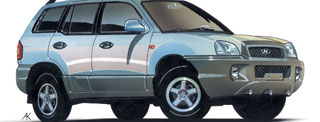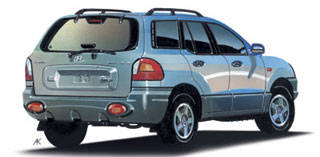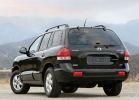Hyundai Santa Fe 2004 test drive - 2006 SUV
Hyundai Santa Fe (2000-2003)
 Santa Fe is the first independent SUV Hyundai. Original and catchy, it is not devoid of specific flaws.
Santa Fe is the first independent SUV Hyundai. Original and catchy, it is not devoid of specific flaws. After several successful years of sales of a modernized, but old Mitsubishi Pagero under its own name Hyundai Galloper, the Korean company decided to produce its own SUV, albeit parquet. Apparently, one of the best representatives of this class was taken as a sample - Lexus RX300. Koreans, with their characteristic scope and zeal, filled car dealerships around the world with cars.
Habitat. An ideal car for women, poor pizons and frivolous sorties into nature. Remote, with a not too nimble engine and automatic trigger. This is how reviews about the car of most happy, however, owners sound.
Appearing in 2000, the machine was originally equipped with two engines: a 2-liter in-line four with a capacity of 136 hp. and a 179-horsepower V6 V6 engine with a volume of 2.7 liters. At the same time, the weaker engine was installed on the front -wheel drive models and aggregated exclusively with a mechanical gearbox, and the second - only on all -wheel drive modifications paired with automatic transmission. Then another power unit appeared-a 2,4-liter gasoline 4-cylinder with a capacity of 145 hp. Alas, in any configuration, Santa Fe accelerates quite reluctantly - the box is openly sleeping for the time being. The 113-horsepower diesel with two liters of working volume, which appeared in 2001, naturally did not differ in particular abuse.
In the domestic secondary market, you can find almost all modifications, although only versions with gasoline engines 2.4 and 2.7 liters are officially delivered to us. A lot of cars come to us from the historical homeland - they are easy to distinguish by signs with hieroglyphs in the cabin. Although there are already owners who reasonably tear them and change them to normal, European ones. After all, relatives are better than non -native - a sweet fairy tale for ignorant: Korean cars are characterized by the same troubles as European.
Three times ugh. Of the general flaws on the machine, regardless of the configuration, the following can be distinguished.
Firstly, the noise insulation of the cabin, especially the doors, is weak. Too many road sounds penetrate the salon, which makes no more comfortable anyone. Similar is treated by installing additional sound insulation from third -party manufacturers - the cost of such tuning is about $ 600.
Secondly, the automatic box is openly stupid with sharp presses on the gas pedal. There is nothing to be done here: the wine lies entirely on the designers, who did not very successfully select the gear rates. The frequency of oil replacement in automatic transmission is every 45 thousand kilometers, and it is strongly recommended to get out of these frames. Moreover, with regular operation on dusty lanes or in conditions of deaf city traffic jams, experts recommend changing oil every 25 thousand km. Fortunately, it is not so expensive - about $ 100 along with oil and work.
Thirdly, paint from plastic parts may begin to get off. It is interesting that this drawback is characteristic of almost all machines produced for the domestic Korean market, and on export versions this trouble was not marked. Repaining plastic panels in a circle will cost about $ 350.
And another detail, which is more likely to the category of curioses, although buyers of used Santa Fe with such a problem for the service come periodically. The fact is that if you put the intensity of the intensity of the wiper brushes to the maximum with intermittent mode, then when stopping at traffic lights, the wipers themselves increase the interval, and when driving at a speed of above 40 km/h, they automatically begin to work continuously. From the outside, it is very reminiscent of artificial intelligence, implanted into the mechanism, at least, and a malfunction of the relay - as a maximum. In fact, this is a proprietary find of Hyundai, and there are no reasons for excitement here.
TABLE AND CHAIR. Santa Fe gasoline versions are very not indifferent to the quality of our gasoline. A pair of incorrect gas stations - and the resource of the spark plugs, which is already at best 30 thousand kilometers, is halved. The replacement works cost $ 25, and the candles themselves - $ 9 apiece. The first sign of car dissatisfaction with the proposed nutrition is an increased fuel consumption. If in normal mode the machine consumes from 12 to 15 liters with a not too aggressive driving around the city, then on critical days the consumption increases to 20 liters per hundred kilometers of the journey. The problem of cleaning fuel nozzles, inlet collectors and replacing the fuel filter is eliminated - in total, it costs about $ 300.
The problem of the diesel engine is almost the same - the incompatibility of the power system with the quality of the domestic diesel fuel. Considering that the machine is equipped with the latest engine with direct fuel injection, which is an original Korean development, you need to be morally ready for the acquisition of a high -pressure fuel pump. This, however, is at least $ 700 per new pump plus $ 250 for the work to replace it.
The next hero in the gallery of subframed problems is the opening cable. From old age, he stretches, from the cold - froze and breaks. In any case, he refuses to let anyone in the motor compartment. Carrying in the collection costs $ 60, and work - $ 25.
 With the world along the thread. There are few problems with the transmission and chassis, but they are all quite annoying. We have already mentioned the machine guns, the pen remained. Everything is quite banal here. On cars of the early years of release, a western clutch pedal was observed. And after a minor run. The reason is the destruction of friction pads, which is also constructive shortage of Korean manufacturers. The fact is that a particularly gifted engineer arranged damping springs on the flywheel, from which, after minor operation, even in sparing mode they destroy friction linings. According to representatives of dealerships, this defect was further eliminated, but if the salon has a smell of paired clutch, a visit to the dealer station will cost $ 300 ($ 220 - adhesion, the rest - work).
With the world along the thread. There are few problems with the transmission and chassis, but they are all quite annoying. We have already mentioned the machine guns, the pen remained. Everything is quite banal here. On cars of the early years of release, a western clutch pedal was observed. And after a minor run. The reason is the destruction of friction pads, which is also constructive shortage of Korean manufacturers. The fact is that a particularly gifted engineer arranged damping springs on the flywheel, from which, after minor operation, even in sparing mode they destroy friction linings. According to representatives of dealerships, this defect was further eliminated, but if the salon has a smell of paired clutch, a visit to the dealer station will cost $ 300 ($ 220 - adhesion, the rest - work). In the suspension, especially in winter, sometimes a knock appears in the front and behind when moving along small bumps called by us the road. Most of the mechanics of the company's company will assure you that this is nothing more than the specifics of gas shock absorbers. Perhaps, but with the only amendment that Korean production. There really is nothing terrible in these knocks, but they annoy people even with strong nerves. The price of the issue depends on your capabilities and desire. We recommend replacing native shock absorbers with Takika or Kayaba. It will cost about $ 400 per set. But you can find both more expensive and cheaper replacement options.
When buying a used car, be sure to pay close attention to the wheel discs. If the original is already killed, then finding an adequate replacement from third -party manufacturers will not be easy. As a rule, only to order: $ 70 is stamping and $ 110 - a cast disk.
Text Denis Redardarchuk, drawing Alexander Krasnov
Hyundai Santa Fe 2.4 2.7 V6
Length/width/height (mm) 4500/1845/1675
Working volume (cubic cub) 2351 2656
Power (L.S.) 145 179
Equipped mass (kg) 1643 1763
Maximum speed (km/h) 173 182
Acceleration from 0 to 100 km/h (c) 11.4 11.6
Fuel consumption (city/highway, l/100 km) 13.1/7.8 14.9/9.4
The cost of spare parts and consumables for Hyundai Santa Fe 2.4*
Spark plug $ 9 ($ 4.5)
Oil filter $ 5 ($ 6.8)
Fuel filter $ 30 ($ 27)
Air filter $ 17 ($ 15)
Front shock absorber $ 88 ($ 110)
Rear shock absorber $ 51 ($ 100)
Clutch assembly $ 228
Front headlight (left) $ 110
Rear (left) $ 80 flashlight
Source: "Autopilot"







